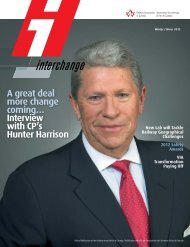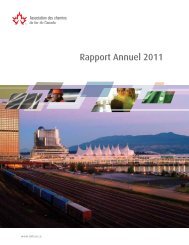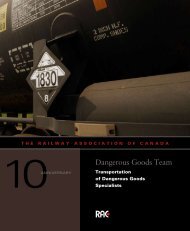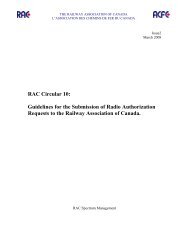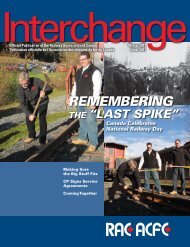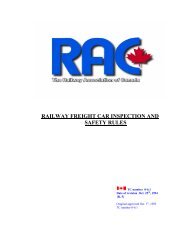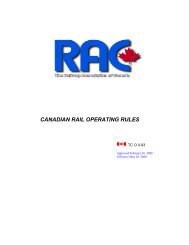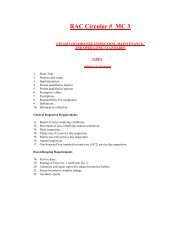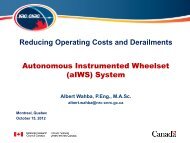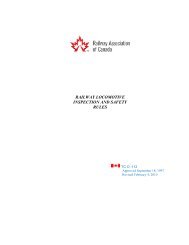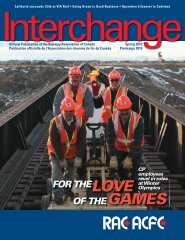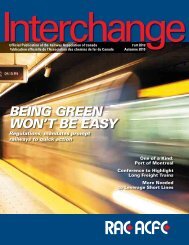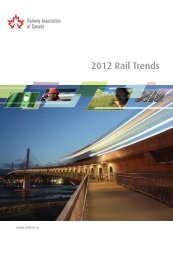Locomotive Emissions Monitoring Program - Railway Association of ...
Locomotive Emissions Monitoring Program - Railway Association of ...
Locomotive Emissions Monitoring Program - Railway Association of ...
You also want an ePaper? Increase the reach of your titles
YUMPU automatically turns print PDFs into web optimized ePapers that Google loves.
7.2.6<br />
Low and Ultra-Low Sulphur Diesel Fuel<br />
Sulphur in diesel fuel influences emissions both directly in the amount <strong>of</strong> SOx produced and indirectly by enabling<br />
exhaust emissions reduction technologies such as diesel particulate filters and oxidation catalysts to function and<br />
not become contaminated 18 .<br />
In harmony with standards introduced in the U.S.A., as <strong>of</strong> June 2007 Canadian refineries are required to limit<br />
diesel fuel sulphur content to a maximum <strong>of</strong> 500 ppm (0.05 per cent), referred to a low sulphur diesel fuel. As <strong>of</strong><br />
2012, ultra-low sulphur diesel fuel (ULSF) having a sulphur content limited to 15 ppm (0.0015 per cent) will be the<br />
only diesel fuel marketed in Canada available to the railways. In view <strong>of</strong> the environmental benefits <strong>of</strong> ULSF, VIA Rail<br />
Canada and the commuter passenger railways standardized on its use.<br />
7.2.7<br />
Freight Car Technology Improvements<br />
The maximum allowable axle load has been increased from 119,545 to 130,000 kg (263,000 to 286,000 lbs) on many<br />
lines in Canada. This means the needed gross tonne-kilometres <strong>of</strong> train consist to move a given amount <strong>of</strong> freight<br />
is reduced. The gross-to-tare ratio <strong>of</strong> such freight cars is increased permitting the railways to reduce the number<br />
<strong>of</strong> railcars without losing capacity. Similarly, to improve gross-to-tare weight ratios, the railways have invested in<br />
lighter-weight aluminum railcars. Also, freight car rolling friction has been reduced through the use <strong>of</strong> steerableaxle<br />
trucks and the universal use <strong>of</strong> roller bearings on running gear. 9<br />
Double-stack container cars permit a higher container cargo volume for a specific train length, thus lowering the<br />
fuel consumption and emissions per RTK <strong>of</strong> intermodal trains. However, on intermodal trains attention is required to<br />
avoid unfilled slots, that is, flat cars without containers. Analyses have shown that improving slot utilization from<br />
90 to 100 per cent reduced the aerodynamic resistance coefficient sufficient to save up to 2.4 L/km <strong>of</strong> fuel 19 .<br />
7.2.8<br />
Longer Trains<br />
Trains up to 2.5 kilometres in length are now operating as a result <strong>of</strong> lengthened passing tracks and sidings. Longer<br />
trains permit improved utilization <strong>of</strong> the locomotive power. In its long trains, CN is deploying Distributed Braking<br />
Cars (DBC) which are placed at the end <strong>of</strong> trains to maintain airbrake pipe pressure at a certain operational level.<br />
The DBC were developed to assist in the operation <strong>of</strong> long trains in cold weather conditions, particularly between<br />
Winnipeg and Edmonton. The concept is based on the older-design air repeater car, which utilized an air compressor<br />
installed in a box car that was placed in the middle <strong>of</strong> the train. DBC obviate the need for additional locomotives used<br />
primarily in long trains to supply additional air for the braking system and, hence, avoiding the concomitant fuel<br />
consumption and emissions. DBC are monitored by a suite <strong>of</strong> proprietary Wi-Tronix s<strong>of</strong>tware that link CN managers via<br />
the internet to provide data on: GPS tracking, fuel levels, refuel alerts, engine monitoring (running state, overload,<br />
oil temperature, and coolant temperature), main reservoir pressure, battery voltage monitoring and the ability to<br />
receive E-mailed alerts 20 .<br />
7.2.9<br />
Remote Power<br />
Distributing a remote-controlled locomotive within a freight train permits better handling <strong>of</strong> long trains, especially<br />
in undulating terrain, so as to provide more optimum locomotive power assignment and better air distribution for<br />
braking. As well, distributing a locomotive within the train helps remove energy-dissipating slack action.<br />
18 Operational Effects <strong>of</strong> Low Sulfur Diesel Fuel in <strong>Locomotive</strong>s, report by Fred Girshick, Infineum USA, published in Proceedings <strong>of</strong> the 70th Annual<br />
Meeting <strong>of</strong> the <strong>Locomotive</strong> Maintenance Officers <strong>Association</strong> (LMOA), Chicago, Illinois – September 21-24, 2008<br />
19 Options for Improving the Energy Efficiency <strong>of</strong> Intermodal Freight Trains, Paper No.1916 by Y.C. Lai and C.P.L. Barkan, University <strong>of</strong> Illinois Urbana-<br />
Champaign, published in the Journal <strong>of</strong> the Transportation Research Board – 2005<br />
20 Wi-Tronix WiPUs to be Installed on CN Distributed Braking Cars, Press Release, Wi-Tronics LLC, Bolingbrook, Illinois – October 18, 2008<br />
29 LEM 2008




